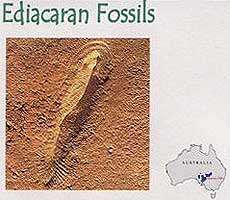 x
x
The South Australian Museum, North Terrace Adelaide 5000 http://www.samuseum.sa.gov.au/page/default.asp?site=1&page=Science_Collections&id=796&fragPage=1
|
БИОЛОГИЯ НА ПОЧТОВЫХ МАРКАХ BIOLOGY ON POSTAGE STAMPS |
Regnum Vendobionta Seilacher, 1992, Dolf, 1992 (now renamed Vendozoa)
(Царство Низшие многоклеточные организмы = Вендобионты) = Inferibionta † - 00054
Divisio incertae †
Genus incertae †
 x
x
![]() [Unknown fossil, ?Kimberella †
00352,
01391]
http://www.abc.net.au/science/news/ancient/AncientRepublish_984724.htm
[Unknown fossil, ?Kimberella †
00352,
01391]
http://www.abc.net.au/science/news/ancient/AncientRepublish_984724.htm
The South Australian Museum, North Terrace Adelaide 5000
http://www.samuseum.sa.gov.au/page/default.asp?site=1&page=Science_Collections&id=796&fragPage=1
Divisio Petalonamae Pflug, 1970 = "Quilted" Vendobionta Adolf Seilacher, 1992 †
Classis Erniettamorpha Pflug, 1972
Familia Erniettidae Pflug, 1972
Genus Ernietta †
Genus Swartpuntia †
[Swartpuntia is a monospecific genus of rangeomorph from
the terminal Ediacaran period, with at least three quilted, leaf-shaped
petaloids — probably five or six. The petaloids comprise vertical sheets of
tubes filled with sand. Swartpuntia specimens range in length from 12 to 19 cm,
and in width from 11.5 to 140 cm. The margin is serrated, with a 1 mm wide
groove. A 14 mm wide stem extends down the middle, tapering towards the top, and
stopping 25 mm from the tip. The stem has a V shaped ornamentation on it. The
original fossils were found at and named after, the Swartpunt farm between Aus
and Rosh Pinah in Namibia. The name Swartpunt means black point referring
to the colour of the rocks. The germsi species name honours Gerard Germs, who
studied the Nama formation of geological beds.
They are preserved in sandstone beds in the Spitzkopf Member from the Nama
formation, which lie above an ash bed dated at 543±1 million years old, and
occur until the very end of the Ediacaran beds in this locality (Narbonne et al.
1997): the start of the Cambrian period is dated 542 million years ago. Whilst
Swartpuntia has since been found in south-western North America, it does not
appear to have had a global distribution — indeed, its seemingly limited range
has been used to provide palæogeographical reconstruction (Hagadorn & Waggonner
2000).
The shape of Swartpuntia resembles other rangeomorphs Pteridinium
and Charniodiscus, both fronds with alternating segments; interestingly,
the segments' microstructure resembles that of Dickinsonia. This
combination of features suggests close relationships between the Ediacaran
biota, and lends credence to their membership of a separate phylum (Seilacher's
Vendobionta).
http://en.wikipedia.org/wiki/Swartpuntia ]
Familia Pteridiniidae Richter,1955 [though maybe this family belongs with the Anthozoa or even the Trilobozoa?]
Classis Rangeomorpha Pflug, 1972 †
Familia Charniidae Glaessner, 1979 †
Genus Charniodiscus Ford, 1958 †
Species Charniodiscus arboreus Glaessner, 1959 † = Charniodiscus arborea Glaessner, 1959 †
Species: Charniodiscus oppositus Jenkins and Gehling, 1978 †, Charniodiscus procerus LaFlamme et al., 2004 †, Charniodiscus spinosus LaFlamme et al., 2004 †
Familia Rangeidae †
Genus Rangea †
Divisio Proarticulata † (Отдел Проартикуляты) [? Classis] [? ‘Metameric’ Taxa]
Ordo Dipleurozoa †
Familia Dickinsonidae Harrington et Moore, 1955 = Dickinsoniidae Harrington et Moore, 1955 †
[The affinities of Dickinsonia are uncertain. It is thought by some to be an annelid worm because it somewhat resembles the Polychaete worm Spinther. It has also been interpreted as a jellyfish, coral, sea anemone, and a lichen. Brian Morton argues that Dickonsonia is close to the ancestry of the chordates. http://en.wikipedia.org/wiki/Dickinsonia]
Genus Dickinsonia Sprigg, 1947 † [также предполагаемый предок (что спорно) кольчатых червей 00007, Венд] http://en.wikipedia.org/wiki/Dickinsonia
Species: Dickinsonia brachina Wade, 1972 †, Dickinsonia costata Sprigg, 1947 †, Dickinsonia elongata Glaessner et Wade, 1966 † = Dickinsonia rex Glaessner & Wade, 1966 †, Dickinsonia lissa †, Dickinsonia tenuis Glaessner et Wade, 1966 †
[И. Т. Журавлева в соавторстве с Е.И. Мягковой опубликовала монографию, в которой дано обоснование совершенно новой системы древнейших примитивных животных, которые были приспособлены к оседлому (прикрепленному к морскому дну) образу жизни с фильтраторным типом питания. Было выделено новое царство организмов Inferibionta с двумя подцарствами - Archaeata (включающая археоциат и другие вымершие группы) и Porifera (ископаемые и современные губки).]
[Ediacaran fossils were described from the Fermeuse Formation on the Avalon Peninsula – specifically, Aspidella terranovica was named – by E. Billings in 1872. A second assemblage was described from Namibia sixty years later (Gürich 1933). Nevertheless, the assemblage acquired its name from a third and even later discovery, made by Reginald Sprigg in March 1946, at an abandoned copper/lead/zinc mine in the Ediacara Hills, Flinders Range, north of Adelaide in South Australia. Since then, occurrences have been located on most continents.]
Divisio incertae †
Ordo incertae †
Familia Spigginidae Glaessner, 1958 †
[Spriggina has been classified as a vendobiont, an annelid 01392 and an arthropod 01393 . It resembles a trilobite 00055 , and may be an ancestor of them.]
Genus Spiggina †
Species Spriggina floundersi Glaessner † [From the Vendian Pound Quartzite of the type locality, Ediacara, South Australia. Overall length about 10 cm.]
__________________________________________________________________________________________________________________
Vendobionta incertae sedis
Genus Mawsonites Glaessner & Wade, 1966 † ["fossil jellyfish"] - [Проблемная систематика, ? Hydrozoa 01396]
Species Mawsonites spriggi Glaessner & Wade, 1966 †
Ссылки - Links
Систематика и доп. иллюстрации даны по
http://bvi.rusf.ru/sista/s50668.htm#t
Фауна этого типа первоначально была названа эдиакарской по названию местности Эдиакара в Южной Австралии
http://evolution.powernet.ru/library/life2/life.html
Лаборатория докембрийских организмов ПИН РАН
http://vend.paleo.ru/collection.php
Википедия
http://en.wikipedia.org/wiki/Vendozoa
The Ediacaran Assemblage
http://www.peripatus.gen.nz/paleontology/ediacara.html
Систематика
http://www.biolib.cz/en/taxon/id427626/
Начато: 20.03.2007 Обновлено: 16.10.2007, 12.04.2008, 05.2009, 03.2010